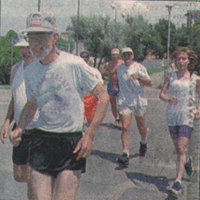LAWRENCE, Kan. (AP) _ Fred Van Vleck was in his late 30s when he helped organize the "Mad Dogs and Englishmen" faculty running group at the University of Kansas.
Back then, 25 years ago, Van Vleck was one of the older runners in the group, which still meets five days a week to run in the noonday sun. But most of the Mad Dogs are now in their 50s, and there aren't many 30-something youngsters.
"It's certainly an aging group," Van Vleck said. "I can't think of anybody you'd consider really young."
Once, it seemed, when the baby boomers were relative youngsters, everybody was running, jogging or doing something healthful. But the baby boomers now are in the stretch run toward Social Security, and the nation's First Jogger himself is over 50.
So where are all the runners now?
They're still around. But the running community has changed, and today's runners aren't as spry as they once were.
"The running scene here continues to grow," said Clark Ensz, a veteran runner and race director in Wichita. "But the runners are definitely older."
That's also true nationally, said Henley Gibble, executive director of the Road Runners Club of America. The RRCA, based in Alexandria, Va., promotes running as a competitive sport and as healthful exercise. It has about 600 clubs and 160,000 members nationwide.
"We have worried about that the last six or seven years," she said.
The RRCA has developed booklets and a videotape that teachers and parents can use to encourage children to take up running and to help them get started.
"Those are our future members," she said.
Anecdotally, some veterans of the Midwest running scene think the runners are aging and the numbers are down.
"I don't see a large number of people in the younger age groups at the races," said Ridge Shannon, for many years an assistant editor of Masterpieces magazine, a bimonthly that covers running in eastern Kansas and western Missouri.
Wes Nicholson, a longtime runner in Topeka, said the over-50 age groups seem to be the largest at local races and in the Sunflower Striders running group he's a member of. "We are getting a few younger ones, but it's mostly just the same people getting older," he said.
Although the runners are getting older, there is no apparent decline in their numbers.
Ryan Lamppa, a statistician with the Road Running Information Center in Santa Barbara, Calif., keeps records on the 100 largest road races in the country. "I think the fact is there is growth," he said. "If we look at the hundred largest races as a barometer of the sport, since 1980 the growth rate has been between 3 and 5 percent a year."
The 100 largest races in 1980 had a total of about 349,000 finishers, he said. The top 100 in 1996 had more than 1 million finishers.
And the big races are getting bigger.
"In 1980 only four races had 10,000 finishers, and in 1996 there were at least 28," Lamppa said. "Many races are social institutions in their town. Races have done a very good job of marketing their events, not only to runners but to their families."
That's the case in Wichita, Ensz said.
"The social part of it has become more important," he said. "As race director I know I spend much time thinking about food and what color T-shirt and all the things that make it a social event."
Over the last 10 years, the number of regular runners -- people who run at least 100 days a year -- has grown from about 8 million to about 9 million, Lamppa said.
"That's not a boom, but it's a steady increase," he said. "Twenty years ago running was something new and novel, a fad. Since then it's become mainstream."
That and the number of baby boomers, compared with the baby bust group today, could explain the large number of young runners back then.
Lamppa and Ensz both said the sport has suffered in this country in recent years because it hasn't had a major star like Bill Rodgers, a four-time winner of the Boston Marathon, or Joan Benoit, who was an Olympic gold medalist in the marathon.
"I think that can make a big difference with younger people," Ensz said.
Ensz said he's noted that more people in the 35 to 40 age range are taking up running for the first time.
"That is the age when you suddenly realize you don't get a free ride to health and you're going to have to work at it to stay healthy," he said.
Van Vleck took up running to get in shape for hiking in the mountains and to lower his blood pressure. Over the years, his children have never shown any inclination to follow in his running footsteps -- until recently.
"One started last year," Van Vleck said. "He's 30. He basically took it up for health reasons."
Copyright 1997, The Associated Press
